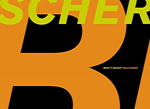 Make It Bigger, by Paula Scher is a mild anecdotal and quiet read. In the odd shaped, and seemingly large book you will find a story of sorts as narrated by its main character (and author).
Make It Bigger, by Paula Scher is a mild anecdotal and quiet read. In the odd shaped, and seemingly large book you will find a story of sorts as narrated by its main character (and author).
More than talking about the end results, Scher talks about the experience of each project. Starting with her first job as a designer at CBS Records, she explains the layout in her office, what kind of people she had to deal with on a daily basis, the common challenges and problems she encountered and the kind of work she did (which I will not go into in this review). You sense a certain growth as the chapter progresses, a less naive designer emerging on the other end, but still one rather self-centered.
Soon after leaving CBS Records, work on two publications (Quality and Together) for Time Inc. provided her with a revelation. She started defining, first publications, and then design in two categories: coping and craving — how to and what you should want. Over the years, this thinking extended to all aspects of design, and she found herself surrounded by one or the other. She also started to discover what kind of client she wanted to work for, and which one could (or should) be ditched. Avoid advertising agencies, but do work for design-related business, and certainly seek entrepreneurs. This may sound obvious to you, though this is rather early in Scher’s career and still trying to figure out how she fit in the professional field. Seeking clients that had a strong voice and opinion, she soon learned how to proceed in a meeting, knowing mid-way if the design was dead or very much alive. Stirring clients one way or another, selling one idea over the others, taking into account the personality types (smart, dumb, lazy, energetic…) she had across the table.
When she started Koppel & Scher with long-time friend Terry Koppel, they distributed a beautiful promotional piece titled Great Beginnings (featuring opening paragraphs from famous novels designed in the period style) which proved to be very successful, as well as defining. Many new projects came their way, and many of them seeked the specific style found in the promo piece which was a frustrating experience for the partners who tried to steer away from this preconception. Many typographical solutions that have shot to fame, stemmed from this.
A while later she worked on �ola. She describes it as the greatest project mainly because of the creative freedom she had, and the two young and daring Swedish entrepreneurs. Later on she has come to realize that she gave the project away financially but has no regrets since she found it to be so fulfilling. Soon after, in part due to desktop technology, she discovered the art of hand lettering through a series of posters and paper promotions (among others) that have led to her now famous obsessive maps (image 1, image 2).
In 1991 she joined Pentagram and quickly learned a few things she had been doing wrong all along, and also realized she had been doing a few things right. She has found it a great place in which to be, since she has the opportunity to work as an independent, while benefiting from the cooperative. She has thrived in this environment, working on all sorts of projects, always in the look out for fun and unexpected experiences that she can obtain with the credibility that Pentagram provides. She prefers to have a balance between what can be deemed as “corporate”, and something “fun and interesting” to keep her focused on both and interested at all times.
This book has provided me with a rather insightful view to the Paula Scher behind the myth. I can see that like the rest of us, she has been afraid, intimidated, shut down and pushed every which way like the rest of the world. She is a strong woman, and her efforts have paid off. But, I can also see this book as a “look-at-me” monograph full of stories and large pictures. The one thing that has left me unsettled, is her over-simplification of the world. People are either smart or dumb, lazy or energetic, design writing is either coping or craving, design projects are either corporate or fun. Clients are worth “it” or not. If “the client” is not a strong individual that has the final word, the project is not as appealing and she seems to lose interest rather quickly. This is of course an ideal situation, but with larger and larger corporations taking over the world this is very hard to find, if not almost impossible. On the other hand, she steers herself away from a “style” that will define her, but if you flip through the book whitout reading the captions or knowing it all belongs to one designer, you will definitely sense a common thread, and a common line of thought. Everything is BIG.
![]()
Make It Bigger by Paula Scher
Hardcover: 256 pages
Publisher: Princeton Architectural Press
ISBN: 1568983328






As you can see, we are trying the book reviews in the "front page" for a little bit.
On Oct.22.2004 at 10:10 AM